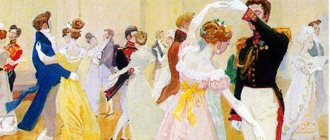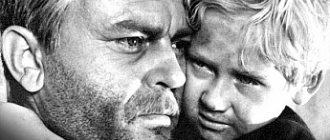Start of work on "Donshchina"
The beginning of the history of writing the novel is considered to be the mid-twenties of the last century. It was at this time, while working on “Don Stories,” that Sholokhov decided to write about how difficult the fate of the Don Cossacks was before the 1917 revolution. In 1925, the writer came to the Don to completely immerse himself in the atmosphere of Cossack life and begin work on the work.
Initially, the writer calls the novel “Donshchina” and writes about 100 pages of the book. Here Sholokhov tells how the Cossacks took part in General Kornilov’s campaign against Petrograd. But then he realizes that events that are close and understandable to him are unlikely to find a response in the souls of readers who are far from the life of the Don farms. The writer leaves work and thinks about writing a larger-scale work, including not only a story about the revolution, but also about the events that preceded it. He feels the need to give a detailed picture of the life of the Don Cossacks, starting from peaceful, pre-war times, to analyze the reasons that prompted the Cossacks to participate in revolutionary events, and to highlight the fates of the most significant characters. Sholokhov changes the title of the novel to “Quiet Don” and begins work on a new book.
Title of the novel
For Russian people, the Don River has become a symbol of the difficult fate of the Cossacks. The calm flow became a way of peaceful life for the people, and then - a witness to the changes caused by the revolution. Since ancient times, the Cossacks have been engaged in agriculture. The Don farms were no exception - the soil there was fertile, so households were located along the banks of the river.
The life of a farmer is measured and comparable to the calm flow of a river. But the usual existence has changed for the population, and the title of the book has acquired a different meaning: this is no longer the calm stream of the Don, but the land of the Don region, which has always been inhabited by Cossacks and has not seen peace in its lifetime.
The history of the creation of the novel “Quiet Don” shows that the title of the book uses a contradictory combination of words, because in Sholokhov’s novel the river is violent, there is a war on it, blood is shed, people are dying. But the generous flow of the quiet Don will not dry up, and the Don Cossacks will not be stopped. And the warriors will return to their homeland, and will continue to live on their land and plow it.
“Quiet Don” - a new idea of the writer
In 1926, Sholokhov finally decided for himself what the new work would look like. From that moment on, he begins to collect factual material for him and settles in the village of Veshenskaya. The story of the novel “Quiet Don” is being continued. In 1927, the writer determined that the book would consist of 9 parts and cover events from 1912 to 1922.
Mikhail Alexandrovich, who grew up among the Cossacks, finds himself in his native element. For him, like no one else, the psychology of the people around him was clear, their way of life and moral values were familiar. However, the writer does not rely only on his own knowledge. He visits the archives of Rostov and Moscow, gets acquainted with Cossack folklore, talks with residents of neighboring farms, and records the memories of participants in the World and Civil Wars.
Although the author revised the text of the novel many times, work on the first three parts was completed quite quickly, by August 1927. In a short time, the author writes the fifth part of the second book, which tells about the events of the revolution and the Civil War. However, external unfavorable circumstances force Sholokhov to significantly slow down the pace of work. The author has been working on the third book for four years, and to finish the last, fourth part of the work, it took him six years.
In the process of creating “Quiet Don” Sholokhov acts not only as a wonderful artist of words. He also manifests himself as a historian and publicist, saturating the text with rich factual material. The second book of the novel depicts in detail and vividly such significant historical events as the February coup, the Kornilov rebellion, the October Revolution and the Civil War. To give greater authenticity to the events depicted, the author includes in the narrative the texts of documents, leaflets, letters and appeals. Historical figures also appear on the pages of the novel, for example: Kornilov, Podtyolkov, Chernetsov, Kaledin, Krasnov. According to researchers, in total, “Quiet Flows the Flow” contains more than 250 real people who organically fit into the overall narrative, along with fictional characters.
The history of the novel
Sholokhov conceived a great novel about the people and revolution in the mid-20s. The desire to create a novel about the Don, to show the Cossacks during the period of dramatic events preceding the revolution of 1917, arose in the writer while working on the Don stories and has not left him since then. With this desire, Sholokhov returned to the Don to be among his heroes. In October 1925, he began work on a novel called “Donshchina.” The work was not easy.
In a conversation with a correspondent of the Izvestia newspaper, Sholokhov recalled how work on the novel began: “I started writing the novel in 1925. Moreover, initially I did not think of expanding it so widely. I was attracted by the task of showing the Cossacks in the revolution. I started with the participation of the Cossacks in Kornilov’s campaign against Petrograd... The Don Cossacks were on this campaign as part of the third cavalry corps. Wrote 5-6 printed sheets. When I wrote it, I felt: something was wrong... It remains unclear to the reader - why did the Cossacks take part in the suppression of the revolution? What kind of Cossacks are these? What is the Region of the Don Army? So I quit the job I started. I started thinking about a broader novel.”
At the beginning of work on the novel, Sholokhov encountered great difficulties. He doubted that he could cope with the task, and also that he had chosen the right path. Having started work on the novel, the writer did not suspect that his plan would result in an epic story about the people's destinies in the revolution. Having written several chapters, Sholokhov put aside the manuscript of “The Don Region” for some time. After the first book of “Quiet Don” was completed and the novel’s action touched upon the events in Petrograd and the Kornilov revolt, the writer returned to “The Don” and included parts of the first version of the novel in the second book of “Quiet Don”. Sholokhov could not limit himself to what he started with - depicting Kornilov’s campaign against Petrograd, the defeat of the rebellion. Even then, he saw his task as “showing the Cossacks in the revolution.”
Having put aside work on The Don, Sholokhov began to think about a broader novel. So, in the process of work, the writer came up with the idea of tracing the ideological revolution of the Don Cossacks, revealing the reasons for the complications of their paths in difficult times for Russia. He understood that without revealing the historically established conditions of life and life of the people, without explaining the reasons that prompted a significant part of them to take the side of the White Guards, the novel, begun by the Kornilov rebellion, the campaign of the Cossack troops on Petrograd, would not resolve the problem of the people’s paths in the revolution. To do this, first of all, it was necessary to reveal the world of his life with all the complexities and contradictions. By moving the narrative back to the time before the imperialist war, the writer sought to show the growth of revolutionary sentiment among his heroes, the scope of the people's struggle for a new life. The transition from one idea to another led to a change in the name of the novel - “Quiet Don”. Sholokhov sought to reveal the meaning embedded in this title through the entire figurative structure of the narrative, as an epic canvas about the fate of the Russian people in their struggle for freedom. The writer set a goal to create the very image of the “quiet Don”, to show the life of the people and the important changes in it caused by the revolution.
“Glorious quiet Don”, “You are our father, quiet Don” - this river has long been called by the Russian people, who connected their lives with it and embodied their great and tender love for it in songs. The title of the novel contains the main idea of the writer, which is also concentrated in epigraphs borrowed, like the title of the novel, from folk art. The life and way of life of the heroes of the work are perceived by the writer as a concrete expression of the life and way of life of various social strata of the Russian people during the period of war and revolution. Along with this, the writer set himself another important task: to follow the tragic fate of individual people who found themselves in a powerful whirlpool of events that took place in 1914–1921. The tragic fate of the main character - Grigory Melekhov - is inextricably linked with the epic theme of people's destinies in the revolution.
The idea for the new novel, according to the author himself, fully matured at the end of 1926. After this, Sholokhov began actively collecting material. It was at this time that the writer moved to the village of Veshenskaya and forever linked his creative destiny with it. Working on the novel required persistent and intense work. The life of a Cossack farm was familiar to the writer from childhood. Knowledge and understanding of this life, way of life, psychology of the people, their customs and morals, nature and work - all this was close and dear to Sholokhov from childhood. Returning to his homeland, the writer settled forever among the heroes of his books. But, despite the fact that they were nearby, Sholokhov made many trips to the surrounding villages and villages, recording the memories of participants and witnesses of the First World War and the Revolution; stories of old people about the life and everyday life of the Cossacks of those years. Collecting and studying Cossack folklore, the writer traveled to the archives of Moscow and Rostov to study newspapers and magazines, get acquainted with old books on the history of the Don Cossacks, special military literature, and the memoirs of contemporaries about the imperialist and civil wars.
After work on “Donshchina” was postponed, Sholokhov carefully thought out the plan for his novel, and in the future he changed only the details, although, according to him, many things had to be rethought and redone many times. Having completed the first three parts of the work, the writer offered them to the magazine “October” and began creating the second book of the novel. In a fairly short time, work was completed on the fifth part of the second book of “The Quiet Don,” which covered the dramatic events of the revolution and civil war on the Don from the end of 1917 to May 1918.
At the end of the first book, depicting the position of Russian troops on the fronts of the imperialist war, Sholokhov began to introduce into the narrative historical and chronicle descriptions and journalistic characteristics related to the analysis and assessment of military operations. The writer resorted to them especially often in the second book of “Quiet Flows the Don,” which is the most saturated with factual material. It depicts the February coup, the Kornilov rebellion, the collapse of the fronts of the imperialist war, the October Revolution in Petrograd and the Don and the dramatic events of the civil war in southern Russia.
In selecting and systematizing material for the novel, Sholokhov did a tremendous and complex job as a historian. He resorted to extensive use of documents, confirming the depicted events and facts by quoting appeals, leaflets, telegrams, appeals, letters, declarations, decrees and orders. Some chapters of the novel are entirely based on these documents. In the process of working on the structure of the book, the author had to intersperse many events, facts, people and at the same time not lose the main characters in them. In the first two parts of the novel alone, the writer introduced more than eighty characters, and by the end of the first book, about seventy new ones were added to them. But only a few of the heroes of “Quiet Don” are introduced into the narrative by genealogical characteristics. Some of them are revealed in certain situations, in the dynamics of the movement of time, others appear in separate episodes and scenes, others are only named, and many remain nameless.
From the very beginning of work on Quiet Don, Sholokhov feared that the depiction of the life of the Don Cossacks could obscure the world of life of his heroes. But this did not happen. Sholokhov conveyed not only a deeply rooted way of life, the relationships of many people in the depicted environment, the intertwining of life's destinies, and the formation of characters. With great skill, he also showed that people themselves come into conflict with established traditions. The “inviolable order” of life gives serious cracks under the pressure of great human feelings, a person’s desire for happiness and freedom. Major social events pass through the soul and heart of the novel's heroes, cause them to think about the unfair structure of life, and bring changes to the people's consciousness.
Working on the final pages of Quiet Flows the Don, Sholokhov sought to convey to the reader the whole truth. The writer was not only a witness, but also a real participant in the events that were reflected in the ending of the novel. He worked in the food detachment and took an active part in the fight against gangs. The author owes many of the scenes included in the last book to personal impressions. However, this was not enough for him. Sholokhov considered it his duty to check his youthful impressions, to collect life facts at the sites of the events described. He tirelessly collected notes from newspapers of those years, questioned eyewitnesses of the events, and traveled to the farms and villages where these events took place. And from all the accumulated facts, the writer chose those that allowed him to fully reveal the complex situation of that time.
Work on the first two volumes of “Quiet Don” took Sholokhov about three years. The first books of the novel that were published aroused great interest both in our country and abroad. “Quiet Don” was regarded as a new bright phenomenon in literature, and Sholokhov himself was regarded as a great artist. In a short time, the novel gained a huge readership. Reviews of the first books of “Quiet Don” did not leave the pages of newspapers and magazines. Sholokhov worked more slowly on the fourth book, delaying publication deadlines, achieving artistic harmony. Readers experienced the heroes’ grief as their own and sent thousands of letters to the author. But the publication of the sixth part of the novel in the October magazine was delayed. Some critics accused Sholokhov of distorting events and called him a renegade.
Throwing from one extreme to another, “Quiet Don” was sometimes called “the greatest epic”, the Cossack “War and Peace”, sometimes “an epic in question”. Soon, a rumor was born in the literary community and began to spread through editorial offices and publishing houses that the author of “The Quiet Don” was not Sholokhov, but a certain white officer killed during the Civil War, from whose field bag Sholokhov allegedly took the manuscript and passed it off as his own. . Sholokhov had to put aside the manuscript, go to Rostov and call a commission to investigate the slanderous facts.
But, in spite of everything, “Quiet Don” passed the main test - time. They read it, are reading it and will continue to read it, admiring the strong characters of the heroes, their ardent and selfless love. The heroes of the novel, like the author himself, love the earth, earthly life, see in it the only source of beauty, and are able to notice a ray of light through any, even the most extreme cruelty.
► Materials about the writer’s work and the novel “Quiet Don”:
- Biography of the writer
- The meaning of the novel's title
- The meaning of landscape
- Poetics of the novel
- Critics about the work of M.A. Sholokhov and the novel “Quiet Don”
Essays
- Female characters in the novel "Quiet Don"
- The Melekhov family in the novel “Quiet Don”
- The problem of a person’s moral choice using the example of the main character of the novel “Quiet Don” by Grigory Melekhov
► Go to the table of contents of the book “Quiet Don” by M.A. Sholokhov. Summary. Features of the novel. Essays
Controversy surrounding the novel "Quiet Don"
The first two books of the novel, published in 1928, brought Sholokhov incredible success. Letters came to him from all over the country. He was invited to performances. But the very next year the situation changed dramatically. Doubts arose that such a young author was capable of creating a work of such artistic power. They began to say that the writer had found the notes of a murdered white officer and passed them off as his own work. Mikhail Alexandrovich has to assemble a commission to defend his right to authorship. Critics also change their attitude towards “Quiet Don”, accusing Sholokhov of showing too much sympathy for the whites and not always presenting the reds in a favorable light. From the “proletarian” writers he was “demoted” to the “peasant” ones.
A very difficult stage appears in the history of the creation of Sholokhov’s “Quiet Don”. The author strives to convey the novel to the reader in an unchanged form, but runs into insurmountable obstacles. So, in 1930, Alexander Fadeev, who took the place of the publisher of "October", refuses to publish the 6th part of the novel if Grigory Melekhov does not join the Red Army. Sholokhov was denied publication even in 1931. Only Stalin's personal instructions save the continuation of the novel from oblivion.
Despite all the obstacles and blows of fate, Sholokhov managed to successfully complete and publish the work in full. In 1941, the writer received the Stalin Prize for it, and in 1965 he became a Nobel laureate.
Collecting materials
The writer intended to convey to the reader the real events of those years, so the history of the creation of the epic novel “Quiet Don” began with Sholokhov’s visit to the archives of Moscow and Rostov. There he studied old magazines and newspapers, read special military literature and books on the history of the Don Cossacks.
With the help of friends who had access to emigrant literature, Sholokhov had the opportunity to familiarize himself with various notes of generals, as well as the diaries of officers, which described military events. When selecting material for the book, the writer did a tremendous amount of historical work. The novel actively uses information from real wartime documents: leaflets, letters, telegrams, orders and resolutions. Sholokhov also added his memoirs to the book - the writer worked in a food detachment and actively participated in the fight against bandits. Thus, many scenes appeared thanks to the author’s personal impressions.
Publication of the novel
The first and second books were a huge success among readers, but problems arose with the publication of the third part. Its first chapters were published in the newspaper, but then these issues stopped. The reason was that Sholokhov was the first of the authors to describe the events of the Civil War in detail and completely. The history of the creation of the novel “Quiet Don” tells that in the third book, entire chapters were cut out by the editors. Sholokhov chose not to make changes.
Literary critics demanded that Grigory Melekhov join Bolshevism, but readers gladly accepted the hero’s choice, since for him this decision became the only correct one. The full text of the work, without editor's edits and additions, was published only in 1980.
The creative history of the creation of the epic novel “Quiet Don” was not easy, but, despite all the difficulties, the novel gained worldwide fame and earned the love of readers from different countries.
Accusations of plagiarism
The first two books, published in 1928, brought the writer great success. He received enthusiastic letters and invitations to perform, but a year later the public’s attitude changed. People doubted that a young and inexperienced author wrote a work of such enormous artistic power on his own. When he began writing “Quiet Flows the Don,” the author was 22 years old, and his literary achievements included only one collection of short stories. Hesitations were also caused by the fact that the author wrote the first two books in just 2.5 years, and yet Sholokhov was considered a poorly educated person, since he graduated only from the 4th grade of school.
Also raising doubts about the authorship was the story of the creation of the novel “Quiet Flows the Don,” a summary of which was allegedly found in the bag of a white officer and published by Sholokhov as his own work. To prove his innocence, the writer had to assemble a special commission and, with its help, refute the slander. As a result of three examinations - graphological, identification and textual - the authorship was confirmed.
Grigory Melekhov
The idea and history of the creation of the novel “Quiet Don” include heroes whose lives the writer tried to inextricably link with the Don Cossacks. Grigory Melekhov combines both individual traits and national characteristics of his fellow countrymen. The writer shows the main character devoted to family traditions, but capable of breaking any norm in a fit of passion. Grigory excels in battles, but throughout the war years he will more than once remember his native land with longing.
Sholokhov creates a hero with great inner strength and self-esteem, and also endows him with a rebellious streak. The turning point in history, which changed the usual order of the Don Cossacks, coincided with changes in the private life of Gregory. The hero cannot figure out who he needs to stay with - the Reds or the Whites, and also rushes between two women. At the end of the book, Gregory returns home to his son and his native land.
Female images in the novel
The creative history of the creation of the novel “Quiet Don” tells that to describe Grigory Melekhov, the author used the image of an ordinary Russian peasant. When writing the main heroines of the work, Mikhail Sholokhov started from his personal ideas about the fate of Russian women.
This is Grigory’s mother, Ilyinichna, who embodies the idea of the unity of all people and motherhood, capable of love and compassion even for people who have caused her pain.
Gregory's wife is Natalya, who takes care of the family hearth, despite spiritual experiences due to her husband who does not love her.
Aksinya stands out for her thirst for freedom and all-consuming love - she believes that a failed marriage absolves her of all guilt for violating norms and prohibitions.
Composition of the work
The work “Quiet Don” is an epic novel, since the book displays the main facts of the First World War and the Civil War, as well as a huge number of heroes belonging to different social and political groups. The events of the novel last a huge period of time - 9 years, describing events from 1912 to 1921. In the work, all the actions of the main character are correlated with the life of the population and nature. The history of the creation of the novel “Quiet Don” shows the contrast in the composition of the book: on the one hand, it is love and peaceful peasant life, and on the other, cruelty and military events.





